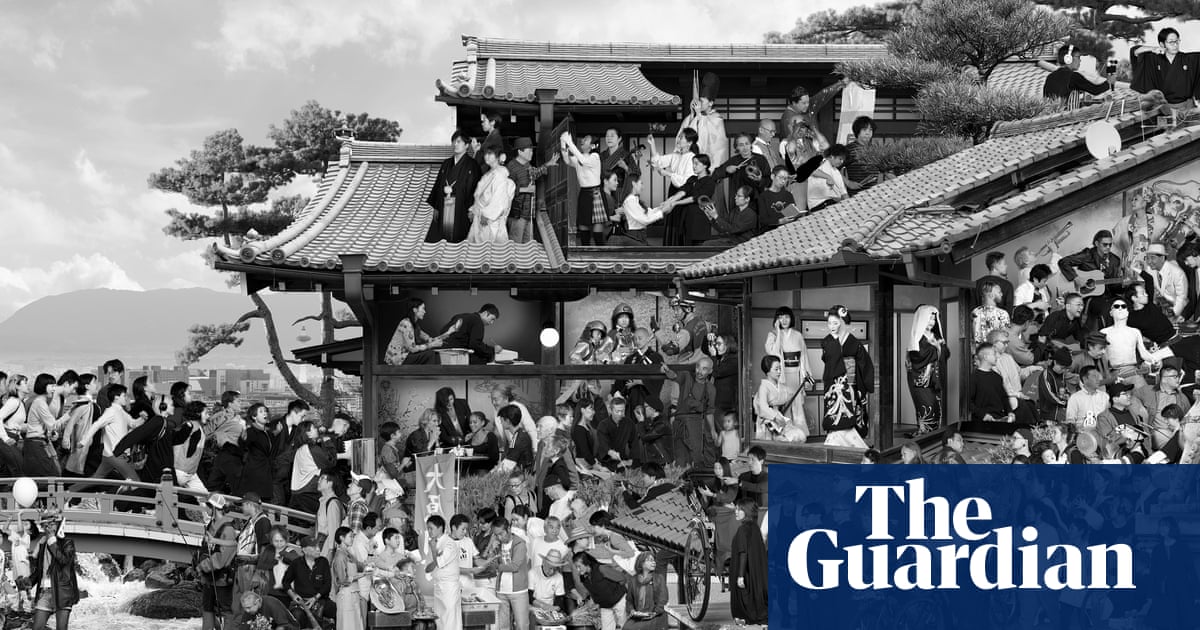Towering above commuters and passersby at Kyoto station is a monumental mural featuring more than 500 portraits of local residents. This striking installation by acclaimed French photographer JR heralds the opening of Kyotographie 2025, the city’s celebrated month-long international photography festival.
The theme for this year’s event is “humanity”. Last autumn, JR and his team transformed Kyoto into a living studio, setting up mobile portrait stations across the city to capture the rich diversity of Kyōto-jin society. Monks, artisans, politicians, schoolchildren and drag queens – all life is here.
The photographer and street artist’s technique is to take each portrait on a greenscreen backdrop, with controlled lighting for continuity, so that they can be easily cut out and placed on a constructed landscape. This is based on spaces and buildings photographed from around the city that are stitched together to create a grand tableau of unexpected interactions.
Each individual is in charge of how they’re portrayed. It’s entirely up to them what they choose to wear and how they pose – there is no direction or choreography from the artist. The only brief for JR is to capture the essence and character of the population and all its vivid qualities.
Many also contribute a brief audio reflection – sharing personal stories or everyday thoughts – creating a collective portrait of the present moment.
Inside the Shimbun Building, a former printing press turned gallery, visitors are led through JR’s creative process via a detailed exhibition. Examples of his large-scale public installations from around the world offer insight into his unique artistic vision.
As always, Kyotographie features a tri-continental dialogue betweenJapan, France and Africa, reflecting the cultural heritage of festival co-directors Yusuke Nakanishi and Lucille Reyboz, who spent her childhood years in Mali. Each year an African photographer is invited to spend a residency in the city to create a unique body of work and this year’s chosen artist is Laetitia Ky from Ivory Coast.
Ky is known for self-portraits featuring elaborate sculptures she makes using her hair. The pictures are quirky and witty but they make a serious point about her relationship with her afro hair and the shadow of colonial legacy affecting her heritage.
Growing up in Abidjan, her friends and family went to exhaustive lengths to live up to an ideal of western beauty involving toxic hair-relaxing chemicals. After undergoing one disastrous chemical treatment herself, Ky discovered a community of women online who were embracing their natural hair and she began to question why she felt the need to alter her true self. Her work is an expression of acceptance and self love that she shares on social media with online communities all over the world and it makes a social and political statement about the complexities of female identity.
During her time in Kyoto, Ky has made an affectionate commentary on her Japanese experience, twisting extensions held with wire into her hair to create an act of self-expression that shares and endorses cultural pride.
African experience is also central to the series Being There created by British artist Lee Shulman in collaboration with Omar Victor Diop from Senegal. This nostalgic journey back in time takes examples of the type of photography that may appear in family albums across North America from the 50s and 60s, a time of segregation and racial inequality, and questions what is absent.
The source images for the project are found or “orphaned” photographs that aren’t attributed to anyone in particular. The pair then add Omar, a black African, into the scene, introducing him naturally in every frame so as not to disrupt the cohesion of the family album. It’s a meticulous process that blends the light and atmosphere and even the surface texture of the original photograph. Displayed in a traditional Japanese home styled as a mid-century domestic setting, the series offers a moving meditation on representation, memory and belonging.
Growing up in Senegal, Omar didn’t experience segregation himself but he feels empathy for those who did. The work he has made over the last 12 years has been about travelling through time to explore the place of African people in the world.
Japanese perspectives are central too. This year marks the return of pioneering Okinawan photographer and activist Mao Ishikawa, now in her 70s. Her 1970s series Red Flower: The Women of Okinawa documents the lives of women – including herself – working in bars frequented by African American GIs stationed on the island. These candid, intimate images confront lingering stigmas and the complex sociopolitical legacy of the US military presence in postwar Okinawa.
Another Japanese highlight is Keijiro Kai, a sports photographer fascinated by the primal intensity of physical contests. From the chaotic Shrovetide football match in Ashbourne, England, to Japan’s Hadaka Matsuri – where naked men clash in a frenzied struggle for fortune – Kai captures the raw, boundary-blurring energy that unites people in shared physical experience. His work is a visceral exploration of masculinity, ritual and collective identity.
Rounding out the festival is the first ever Japanese retrospective of legendary Mexican photographer Graciela Iturbide. Spanning six decades, the exhibition traces her poetic journey across deserts, mountains and cultures – from the indigenous Seri people in the Sonoran desert to Zapotec women in Oaxaca, and beyond. Inspired by Henri Cartier-Bresson’s “decisive moment”, Graciela’s memorable images – such as the majestic Angel Woman or the iguana-crowned Nuestra Señora de las Iguanas – merge documentary precision with spiritual wonder.
Now in her 80s, Graciela is still taking pictures today. Included in the curation is a reportage series commissioned by Dior for Vogue Mexico in 2023. The work is a perfect example of the creative intelligence and dynamic character that continue to define her.
